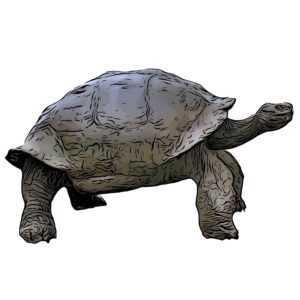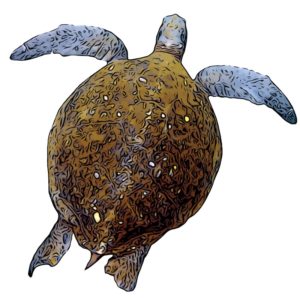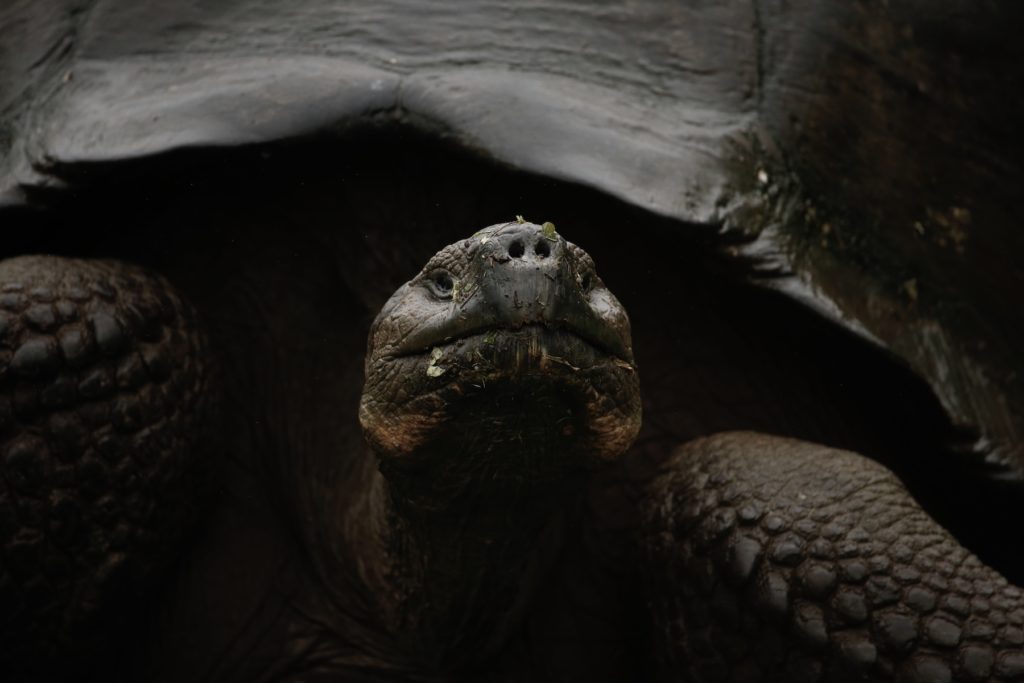
Galapagos Giant Tortoises
(Shells vary between dome and saddle shaped)
Where to Look
- Santa Cruz Highlands
- Lagoons on Larger Islands
Related Galapagos Species

Green Sea Turtle
(Chelonia mydas)

Identification
No two species of Giant Tortoises frequently co-occur.
Description
One of the Galapagos’ most iconic and famous group of species, Galapagos’ Gaint-Toirtoises are the focus of much research and conservation action. Of the 14 species, all are endemic, 2 are extinct and 6 are critically endangered. All species can be seperated from each other by the localities at which their ocuur. Species vary from each other in size and shell shape. Famously, species found on drier islands have a saddle-shaped shell and those found on more vegitated islands have a dome-shaped shell. While the saddle-shaped shell allows individuals on drier islands to extend their necks to feed on multiple levels of vegitation during droaghts, the dome-shaped shells of tortoises found on wetter islands help them move through thick vegitation more effectively. Males are significantly larger than females in all species. These are the only tortoises found in the Galapagos.
Pinta Giant Tortoise
Chelonoidis abingdonii
Extinct. Historically found on Pinta Island.
Wolf Volcano Giant Tortoise
Chelonoidis becki
Vulnerable. Found around Wolf Volcano on northern Isabela. Very common localised endemic resident. More than 50% of population dissapeared in last 180 years due to harvesting by fisherman and predation and habitat destruction by introduced rats, pigs, dogs and goats. Total population at 10,000 – 12,000. The volcanic eruption of Wolf Volcano is also a major threat.
San Cristobal Giant Tortoise
Chelonoidis chathamensis
Endangered. Common endemic resident. Previously found across San Cristobal, this species now persists only in the central north-eastern region of the island. Declined from roughly 24,000 to 500 in 1970’s, now at 6,700 (2016). Primary decreased caused by harvesting of tortoises for export to produce oil. Population also affected by introduced species such as rats, pigs, donkeys, dogs, dogs and goats).
Santiago Giant Tortoise
Chelonoidis darwini
Critically Endangered. Common endemic resident. Restricted to the highlands of Santiago. Declined from roughly 24,000 to 500 in 1970’s, now roughly 1700. Exploitation by sailors for food and introduced species.
Don Fausto's Giant Tortoise
Chelonoidis donfaustoi
Critically Endangered. Common endemic resident. Found in the eastern highlands of Santa Cruz. Declined from 13,500 to 550 today. Low genetic diversity, introduced species, competition with agricultural land.
Pinzon Giant Tortoise
Chelonoidis duncanensis
Vulnerable. Common endemic resident. Endemic to Pinzon Island. Decline from 850 to 100-200 in 1970’s to 800 now. Overexploitation by sailors, black rats killed all tortoise hatchlings, but were finaly irradicated from Pinzon in 2012.
Sierra Negra Giant Tortoise
Chelonoidis guntheri
Critically Endangered. Common endemic resident. Found on and near Sierra Negra Volcano in southern Isabela. Declined from 71,000 to 300-500 in 1970’s to 400-700 individuals now. Extensive overharvesting as distributed near penal colony, WW2 military base and foundations of puerto villamill in South Isabella. Introduced species, including fireants. Volcanic eruptions.
Espanola Giant Tortoise
Chelonoidis hoodensis
Critically Endangered. Common localized resident. Endemic to Espanola. Declined from 2,400 to 14 in 1960’s to 860 today. Introduced goats and extensive overharvesting.
Darwin Volcano Giant Tortoise
Chelonoidis microphyes
Endangered. Common localized resident. Found only on the south-western slope of Darwin Volcano Declined by up to 95% from pre-human influence to 500-1000 today. Overharvesting, introduced species. Volcanic eruptions.
Floreana Giant Tortoise
Chelonoidis niger
Extinct. Historically found across Floreana Island.
Fernandina Giant Tortoise
Chelonoidis phantasticus
Critically Endangered. Extremely rare endemic resident. Found in wooded areas on Fernandina Island. This species was known only from 1 collection in 1906. In 2019 a lone male was found on the island and relocated. As there are no introduced species on the island, it is thought that the species succumbed to volcanic activity.
Santa Cruz Giant Tortoise
Chelonoidis porteri
Critically Endangered. Very common endemic resident. Found in the south west of Santa Cruz Island. Declined from 34,000 to 3,400 today. Overharvesting, agriculture, introduced species (including fireants).
Alcedo Giant Tortoise
Chelonoidis vandenburghi
Critically Endangered. Very common endemic resident. Endemic to the region around Alcedo Volcano on central Isabela. Declined from 38,000 to 6,320 today. Introduced species, never really exploited due to remoteness. Eruption the most likely explination for low genetic diversity.
Cerro Azul Giant Tortoise
Chelonoidis vicina
Critically Endangered. Common endemic resident. Found on Cerro Azul Volcano on south west Isabela. Declined from 18,00 to 400-600 in 1970’s to 1,800-2,700 individuals. Overexploitation by sailors, introduced species, volcanic eruptions.
Global Distribution
All twelve surviving species are endemic to the Galapagos archipelago.
